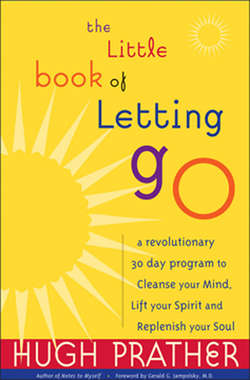Читать книгу The Little Book of Letting Go - Hugh Prather - Страница 21
На сайте Литреса книга снята с продажи.
Attitude 2: Failure to worry is risky, if not dangerous.
ОглавлениеThe general assumption is that if you are “a happy camper” today, tomorrow “the other shoe will drop.” “Happy-go-lucky” is the same as “devil-may-care”—and we all know what happens to those who don't worry (care) about the devil. The word happy itself is sometimes used as a substitute for “reckless,” “crazy,” or “lacking good sense,” as in “slap-happy,” “power-happy,” “divorce-happy.” Many children were raised hearing this cautionary theme in stories such as the parable of the silly grasshopper who enjoyed summer versus the wise ant who spent summer collecting food for winter (then had the self-righteous pleasure of refusing to help the starving grasshopper!).
Furthermore, we all grew up seeing—and more importantly, feeling—our moms and dads worry about their weight, the weather, insurance, bank balances, and a hundred other concerns. Most school-age kids, having parents who are too careless or insensitive to shield them from their fights, and who already know many kids with step- or single parents, worry about whether their own parents are going to divorce. This can become a particularly deep-rooted and debilitating worry because it relates to safety, self-esteem, and survival. For this and many other reasons, most of us begin our adult years with the basic fear that nothing is reliable, not even our home.
Not only is worrying fanned through parental insensitivity, most parents aggressively teach their children that they should and must worry—about how much or little they eat, about catching an endless list of diseases, about whether they can trust their own basic nature or common sense (“I can't let you out of my sight,” “You don't care about anyone but yourself”), and about “too much junk food,” “certain people,” bad grades, and on and on.
Moreover, as children we were given grounds for a basic all-pervasive worry through every “Are you sure?” question we were asked:
“Are you sure that's the water gun you want to buy? This green one will last longer.”
“Are you sure you want to invite Ian to your birthday party? Remember, he didn't invite you to his.”
“Are you sure you don't need to study for the parts-of-a-flower test? You don't want to end up pumping gas for a living.”
“Are you sure he/she's the right one for you, dear? You don't want to start dating again after you've lost your looks.”
Even though our propensity to worry comes primarily from our childhood interactions with our parents, other sources contribute mightily. The underlying sense that it's good to worry is part of our overall culture. In the West, we join together daily to hear endless reports of problems with no thought of seeking solutions ourselves. Drinking in the problems is satisfying enough, and the media knows it.
Religion, which should foster comfort and healing, can promote worry, if not terror. Ministers, priests, and rabbis often use fear to sell doctrine and increase contributions. Even many twelve-step groups try to motivate through fear.
Clearly, our educational system fosters anxiety as well. Our schools set impossible goals, all the while dispensing “consequences” for a bewildering array of “inappropriate” behaviors. Grades K through 12 have multiple and, in many ways, conflicting aims: responsibility, socialization, selfesteem, environmental consciousness, creativity, racial pride, drug awareness, time management, and the like. Homework assignments are constructed to reflect so many different values that most kids don't know what the teacher expects. Teachers themselves vary widely in how they want to influence their kids because the textbooks and curriculums they are handed contain complex and confusing compromises.
Behind all these early lessons from culture, home, church, and school can be heard a drumbeat of conflicting warnings: “Better watch out,” “Go slow,” “Use your head,” “Watch your step,” “Watch your back,” “Know who your friends are,” “Trust no one,” “Mind what you're doing,” “Look ahead,” and, my favorite, “Think twice.” Obviously there are ways to use these sayings well, but like today's “spiritual” worries (“Be mindful,” “Be aware,” “Watch what you're putting out there,” “Fears are self-fulfilling,” and perhaps the scariest of all, “Remember, you create your own reality”), they contain one underlying message: We are more alert and better armed when we are anxious.
That's absolutely not true. The opposite of a worried mind is not a foolish mind, but a still mind. The simple, observable fact is that a worried mind is busy, cluttered, and scattered, whereas a still mind is more capable of broad, steady awareness, if for no other reason than it is less distracted. A worried mind provides no protection. A still mind can assess the surrounding situation more quickly and accurately than a mind dominated by anxiety and thus is less likely to overlook a present danger.
